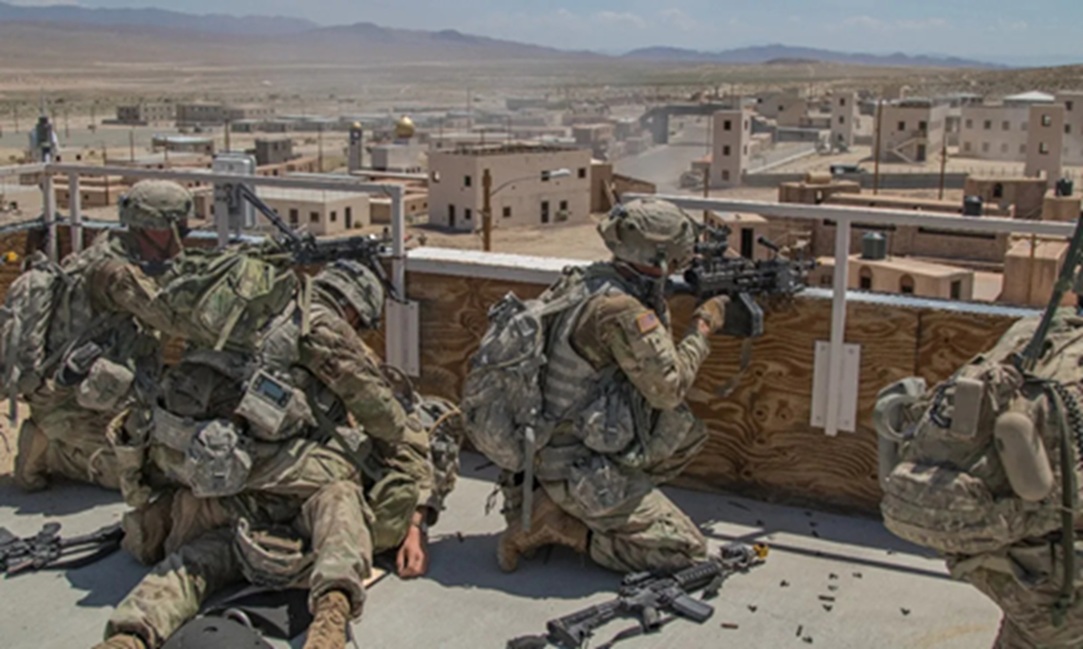The Government of India is pushing for the indigenisation of military hardware by curtailing defence imports in a progressive manner. Defence equipment production in the country is finally going up and can achieve the targets set by the Government in the coming years.
Bharat has become a power to reckon with in this 21st century. The successful conduct of the G20 Summit has further elevated our position as the champion of the global south and as an emerging superpower. With its growing stature as an influencer and arbiter of international peace and security, Bharat will have to shoulder many challenging responsibilities in future. Peacekeeping and peace enforcement under the aegis of the UN or as a partner of multilateral agencies, global climate change mitigation, disaster relief, pandemic relief and nuclear disaster are a few. There is a need to scale up India’s defence capabilities to match the country’s growing stature as an emerging superpower.
The existing inventory of our Armed Forces can provide a reasonable deterrence against our immediate neighbours. But our main adversary China, is modernising and expanding its military capabilities in an unprecedented manner to counter the mighty US. China has indigenously developed; fifth-generation stealth fighters, 85,00-ton aircraft carriers, robot soldiers, Ballistic Missile Defence (BMD) and even Anti Satellite (ASAT) weapons. China will remain a major threat to us in future. In order to counter China and match its stature, our Armed Forces need to be provided with fifth and sixth-generation defence equipment. It is difficult to buy these high-tech equipment from abroad due to exorbitant costs and restrictions therefore, these cutting-edge military equipment need to be designed and manufactured indigenously.
This article endeavours to highlight the different areas in which MSMEs and Start-Ups can contribute in the field of defence equipment manufacturing, the challenges they presently face, and how adapting global practices and established processes can help in developing a more robust and inclusive indigenous manufacturing ecosystem.
Indian Armed Forces at the Cusp of Modernisation, Upgradation and Expansion
India’s Armed Forces is the fourth largest in the world, with an inventory of legacy and state-of-the-art equipment. Our home-grown assets include fighter (LCA), helicopters (ALH, LCH, MUH), UAV/UCAV (Netra, Panchi, Ghatak), Combat Air Teaming System (CATS), CATS Warrior, naval platforms (aircraft carrier, nuclear submarines, Amphibious Transport Dock, Tank Landing Ship, Destroyers, frigates, nuclear powered ballistic submarines, corvettes and patrol boats) missiles (BrahMos, Agni, Prithvi, Nag, Pinaka, XRSAM, Shaurya, Astra), ), tanks (Arjun, Vijayanta, Ajeya), Artillery Guns (Dhanush, K9 VAJRA-T 155MM/52, Advance Towed Artillery Gun System (ATAGS), Standoff Anti Tank Missiles, Rifles (assault, sniper, machine guns, grenade launchers) etc. Many of our weapon delivery platforms and weapon systems are of fourth and less than fifth-generation grades.
Major military powers in the world viz; USA, Russia and China have already developed and are operating fifth-generation platforms which have; stealth, high speed, high maneuverability and autonomous capabilities with Artificial Intelligence (AI) and Machine Learning (ML) embedded systems to be effective conventional war, gray-zone conflicts, asymmetric fights, and high-end wars. India as an emerging superpower, needs to modernise and expand its weapons and weapon delivery platforms to cater to defending our territorial security and to protect the country’s interests across the globe. Though the Armed Forces are now looking towards Indian OEMs and MSMEs for the design and manufacture of fifth-generation systems, the realisation of the projects is well behind the induction schedule.
Next Generation Equipment & Weapons for the Indian Armed Forces Need to be Made in India.
In spite of the concerted efforts of successive governments in the past 76 years to manufacture defence equipment indigenously, about 48% of our military inventory is of foreign origin. As per the report released by the Stockholm International Peace Research Institute (SIPRI) in 2023, India continues to be the largest importer of arms. In the 2023-24 Union Budget, the Govt has allocated Rs one lakh crore for the procurement of indigenously developed defence equipment. Though, it seems a large amount, much of the high-value cutting-edge technology equipment for the Indian Armed Forces; especially fighter and transport aircraft, surveillance platforms, artillery and assault rifles etc are still being sourced from abroad.
The indigenous development of high-end technology is fraught with many challenges; non-availability of critical technologies, high cost involved in the R&D, skilled engineers and above all funding constraints. Therefore, it is important that the DPSUs undertake the responsibility for the design, development and integration of the next-generation defence equipment in collaboration with MSMEs and Start-Ups for the manufacturing of the systems and sub-assemblies.
Atmanirbhar Bharat – Unprecedented Opportunities for MSMEs and Start-Ups
The MSMEs and Start-Ups have great opportunities to participate in India’s quest for self-reliance in the design and manufacturing of next-generation defence equipment needed for our Armed Forces. Some of the opportunities offered by the Government of India are:-
(a) Technology Development Fund. DRDOs have been allotted funds for Technology Development, which is exclusively for the MWMEs and Start-Ups.
(b) iDEX. Innovation for Defence Excellence (iDEX) aims to achieve self-reliance and foster innovation and technology development in Defence and Aerospace by engaging Industries including MSMEs, start-ups, individual innovators, R&D institutes and academia.
(c) Atmanirbhar Bharat in Defence Production. With large-scale modernisation requirements of the Indian Armed Forces, India’s vision for Atma Nirbhar Bharat has provided further impetus to realise the goal of indigenisation of the Defence Sector. Under the Atmanirbhar Bharat initiative, a total of 411 products have been identified so far for indigenous production.
(d) Aerospace & Defence Corridors. The Govt has created an Aerospace and Defence corridor in Uttar Pradesh and Tamil Nadu. The MSMEs and Start-Ups setting up their venture in these Aerospace and Defence corridors would be eligible for land at a concessional rate, easy capital and assured business. Apart from these corridors, dedicated defence and aerospace parks are also available with tax holidays.
(e) Sarjan Portal. This is a portal of Hindustan Aeronautics for the benefit of Indian industries for participation in the indigenous design and production of various parts for aircraft, test equipment software etc. MSMEs and Start-Ups can directly bid for the design and manufacture of HAL-made aircraft and systems.
Recommendations
Around 12,000 MSMEs and Start-Ups are currently supporting the DPSUs and Armed Forces in supplying defence equipment and providing services; particularly IT and IT-enabled services. These MESMEs and Start-Ups have the potential to contribute more to the defence sector. A few recommendations which would help the MSMEs and Start-Ups to design and develop futuristic military equipment and services are:-
(a) Adapt global standards for the design and manufacturing of products and services.
(b) Obtain DGQA/CEMILAC/AS 9100/ISO 9001 certification for the unit/product/services.
(c) Form consortiums to leverage multi-sectoral competency for the design and development of products necessitating integration of parts; machined, electronic, pneumatic, hydraulic and software (AL&ML) etc.
(d) Obtain Start-up certification for funding and tax benefits
(e) Exploit the expertise and services of defence veterans at all levels, who could help to reduce the cycle time from design to manufacture and mitigate the communication gap existing between the end user and designer.
Conclusion
MSMEs and defence Start-Ups in this country can contribute a lot to convert India from the largest importer of weapons to a net exporter of defence equipment. The defence MSMEs and Start-Ups in the country are facing many challenges. Unless the GoI takes the role of an envisioner of targets, enabler and facilitator of technology and an agency to go to, the contribution of MSMEs and Start-Ups towards self-reliance in defence equipment will continue to be unsatisfactory.
The Armed Forces veterans with the vast knowledge and experience in operating and maintaining defence equipment and systems, have a great potential to be a part of India’s efforts to become self-reliant in defence production. Uncertainty in the Return on Investment (RoI) and an unfriendly business environment are the major inhibiting factors which restrain the veterans for a second innings. If the enabling and facilitating policies are implemented along with funding from banks, these veterans can become a force multiplier in India’s drive towards self-reliance in defence production.
Disclaimer: The views and opinions expressed by the author do not necessarily reflect the views of the Government of India and Defence Research and Studies





